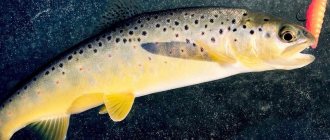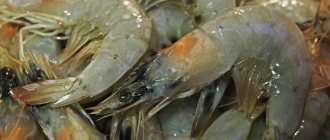Maria_Ivanova22 — Jan 13th, 2021 Categories: How to store
Trout is a very tasty and healthy product, but, like all fish, it spoils quickly. In addition, failure to comply with storage rules threatens severe poisoning of the body.
Ingredients: trout Time to add: All year
Fresh and frozen trout require different storage conditions that you must know.
How to store trout in the refrigerator - timing and methods
Tasty and healthy food should be fresh.
A good housewife knows about this and always monitors the storage of food supplies. The refrigerator helps preserve food for as long as possible. On its shelves there will always be vegetables, canned food, meat and fish. In this article we will talk about the rules for storing the latter, and in particular, trout, beloved by many. Trout is one of the most nutritious and healthy types of red fish. The product is consumed fresh (freshly caught) or stored at low temperatures. We will tell you further how long you can store trout in the refrigerator and how to do it correctly.
Storage rules
Freshness of the product is the most important rule when purchasing. Always check the expiration date before you make a purchase . Trout that you do not cook immediately should only be stored in the refrigerator.
Attention! After purchasing, the frozen carcass should be immediately placed in the freezer. It is important to exclude defrosting and partial thawing. Repeated freezing leads to the proliferation of dangerous bacteria. They not only spoil the taste of the fish, but also harm the body.
To buy a high-quality and fresh product, you should study it carefully . Quality trout has a faint marine or iodine odor. Shiny uniform scales and bright translucent eyes are a sign of fresh fish.
The ideal option is if the product is stored in a container with ice in the store. This makes the cooling process more efficient.
Fresh trout in the freezer
Is it possible to freeze trout purchased fresh ? You can, but only cleaned and gutted. It is important to remove excess moisture from the product. Excess water will disrupt the structure and taste of the meat when defrosting.
Important! To preserve the taste and structure of the product, the fish is wrapped in parchment or polyethylene before freezing. You cannot store fillets and uncleaned carcass in the same package. Bacteria from the scales will get onto the cleaned fish and lead to its spoilage.
We explained how to freeze trout, but many housewives are interested in the question of how long it will retain its freshness in this form. The fish has fatty meat, so it can be kept in the freezer for no more than six months .
Defrost the product without additional heating at room temperature. Also, do not use hot water. Fish cannot be re-frozen - this will lead to spoilage of the product.
Salting trout after freezing is not recommended . It’s better to do the opposite: first pickle and then freeze. This way the meat will retain its juiciness and taste.
About storing other products:
Fresh trout in the refrigerator
If you plan to cook trout in the near future, you won’t need a freezer. The fish will survive 24 hours in the refrigerator .
At a temperature of 0...+3°C, it is important to store fresh trout without entrails. It is gutted, washed, removed from excess moisture and placed in a bowl. Cover the container with cling film and put it in the refrigerator.
The maximum shelf life is 2 days. To ensure the freshness of the meat, it is placed in salt water and then in the refrigerator. Lemon juice will cope perfectly with the task of temporary storage. The trout will be slightly preserved and will become more tender.
Reference! “Grandmother’s” advice is widely used among housewives. You can prolong the freshness of the product using folk methods, for example, by placing mint or wormwood nearby. If you place a piece of bread dipped in vodka next to the fish, the fillet will retain its juiciness.
Fish carcasses should not be stored in the refrigerator next to dairy products . This will negatively affect their quality and smell.
The salted version of the fish is very popular. This product is stored much longer than fresh . Purchased lightly salted trout remains fresh in the refrigerator for up to 1.5 months. The main features are vacuum packaging and the correct temperature range: from -9°C to -5°C.
Trout salted yourself can be stored for no more than 1.5 weeks . The fillet is moistened in marinade or acetic acid, wrapped in cellophane film or a bag and placed in the refrigerator.
It is important not to create sudden temperature changes - this will cause the trout to lose its unique taste. If the product is consumed in portions, then after separating the desired part, the rest should be immediately refrigerated.
Trout is a real delicacy. Many holidays cannot do without it, especially the New Year's table. Having conceived the idea of serving a dish, housewives purchase food long before the celebration. The question arises how to preserve fresh trout until the New Year.
The storage method depends on the expiration date of the product and the date of purchase . Trout doesn't stay fresh for long, so you shouldn't buy it in advance. Be sure to store in the refrigerator. Fish purchased two days before the feast can be placed on an ice bed, and frozen a month before.
Chilled trout in the refrigerator
Let's look at how to store chilled trout. In a store refrigerator, the product stays fresh for up to a month, but at home – up to several days. This is due to the difference in storage conditions. If the trout is not eaten for more than three days, it is recommended to freeze it.
When chilled, fish is better stored on an ice bed . You will need special ice trays or freezer bags. The carcass can be pre-lubricated with vegetable oil or a weak vinegar solution to increase shelf life. It is important to rinse the product thoroughly before use.
Carefully! After several days of storage on an ice bed, the trout becomes covered with a slight coating. But don't rush to throw away the product! The plaque can be cleaned off and the fish can be cooked in the shortest possible time.
How long you can store chilled trout in the refrigerator is said, but it is no less important to place it correctly. Do not keep a chilled carcass near smoked products and sausages . The meat will absorb the smell and change the taste.
Fresh trout without refrigeration
There are cases when storing trout in the refrigerator is impossible . For example, fishing. The situation is not a problem in winter, but in summer it is much more difficult to preserve fish. Warm weather encourages bacterial growth, leading to immediate spoilage.
As long as the fish is alive, it will not spoil . A cage or kukan will help maintain the vital activity of trout.
It is important to choose the right place to place the cage. Conditions for storing trout are as follows :
- shade or shelter from the sun;
- constantly renewed water, but without strong currents;
- low water temperature.
Be careful when moving fish into the tank. The slightest injury will lead to death. Periodically you need to check if the fish has fallen asleep. If you fail to keep the trout alive, follow these recommendations :
- Gut the carcass - remove all entrails, enzymes and blood clots by rinsing with water or wiping with a clean rag.
- You cannot clean fish of scales - this is a barrier against the penetration of bacteria into the cavity.
- Use bactericidal agents. Salt or vinegar will help, as well as natural preservatives: nettle, bird cherry, sedge, plantain. Plants contain special substances that destroy bacteria. For greater effect, nettle leaves are placed inside the carcass. Dehydration will help slow down the growth of bacteria: the fish is salted or dried.
- Reduce the temperature of the trout. Natural “refrigerators” are earth, spring water, ice.
Ventilation increases the shelf life of the product . It is not recommended to keep fish prepared for storage in closed containers or bags. It is wrapped in cloth or placed in a wide container and covered with gauze on top.
Signs of poor quality fish
Fish can spoil not only from improper storage conditions . There are often cases when a stale product is purchased in a store.
The following signs indicate questionable quality::
- Strong smell of fish or ammonia. The fresh product has virtually no odor.
- Cloudy eyes of a dark color.
- The gills are covered with mucus and are dirty gray, brown or yellowish in color.
- Dull scales, sticky, with clots of mucus, crumble.
- The swollen belly of the fish, the meat, is easily separated from the skeleton.
- With slight pressure, dents remain on the carcass, which do not smooth out over time.
- The fillet has ragged edges and spots.
- The tail of frozen fish appears dried out or curled up.
- The trout looks shapeless and shabby.
How to choose red fish
On the shelves of shops and markets you can find red fish in the following form:
- fresh or chilled;
- pickled;
- salted or lightly salted;
- frozen;
- smoked.
When purchasing and choosing fresh fish for salting at home, you need to follow the basic rules:
- her eyes should be transparent;
- skin and scales – shiny;
- the carcass itself has a pleasant, faint odor;
- gills – bright;
- when pressing on the carcass, the skin and flesh are elastic and quickly restored;
- A cut of high-quality red fish should have white veins.
Attention! The main criterion for choosing fresh products is the gills. If they are white, brown or green, you should avoid purchasing them.
When purchasing in vacuum packaging, you should carefully inspect its integrity. Do not purchase the product if the packaging material is damaged or severely wrinkled. If there is liquid inside the package, the technology for preparing the product is most likely broken. Steaks, fillets and cut fish or mosaics are sold in a vacuum. It is better to avoid purchasing the last two options, despite all the ease of use. It is impossible to assess the quality of a product by looking at its appearance; it is also difficult to understand what kind of fish is contained inside. Unscrupulous manufacturers sometimes use coloring compounds to turn less valuable white fish into red ones.
How long can chilled trout be stored in the refrigerator?
Fresh fish and seafood not only taste great, but also have great health benefits. If you are interested in how to store fish so that it remains fresh longer than after the catch, then when buying it you need to pay attention to its appearance and smell. While the old German saying is true: “The oven is the best place for freshly caught fish,” there will be times when you will need to store it or seafood for several days before cooking.
How to store fish correctly?
Since fish has an exquisite taste and is very healthy, it is not surprising that nutritionists recommend eating it at least once a week. However, fish will not retain its freshness if it is stored in a regular refrigerator. We are pleased to inform you that Liebherr refrigerators have all the conditions for optimal fish storage.
The fresher the fish, the longer it can be stored. So, how can you tell if fish is fresh or not?
- The fish should have a faint odor, in most cases the aroma of the sea or iodine. Stale fish has an unpleasant odor.
- Shiny, firm and elastic scales are a sign of fresh fish.
- Fresh fish have open, protruding, bright and translucent eyes. Dull and gray eyes are characteristic of stale fish.
- The gills should be light and shiny. Yellow and brown shades characterize stale fish.
- If possible, use your index finger to press firmly onto the scales of the fish. Fresh fish will be firm and elastic, and there will be no mark left on the scales after pressing. Flat fish should not lose their shape when you pick them up.
Let's look at a few important rules on how to properly store fresh fish.
How to store fish in the refrigerator?
Storing fish at the right temperature is the key to success
The microorganisms contained in fish affect its shelf life . The refrigerator slows down the activity of microorganisms and extends the shelf life. However, the temperature of +5°C in ordinary refrigerators is not suitable for storage, since the optimal temperature range is from -2°C to 0°C to preserve fish and seafood. For this reason, in ordinary refrigerators, fish will remain fresh for a day, so it can only be stored for one day. Of course, you can set the refrigerator temperature lower, but then it will be too low for other foods. To solve this problem, it is best to take a separate container filled with ice cubes and place the fish in it. Thanks to this, you can store it in a regular refrigerator for one or two days longer.
Everything is much more convenient if you have a refrigerator with a BioFresh section, and even better if with BioFresh-Plus. The question arises: “How long can fish be stored in this area?” The BioFresh container maintains a temperature of approximately 0°C, which allows you to extend the shelf life of fish up to two days.
At -2°C fresh fish can be stored in the BioFresh-Plus container for up to 4 days.
Fish retains its freshness even better for four days in a BioFresh-Plus container at -2 °C. Refrigerators with BioFresh and BioFresh-Plus are ideal for anyone who wants to enjoy the pristine taste of fresh fish and seafood.
How to store fish in large quantities?
Fishing enthusiasts have a need to freeze large quantities of fish. Before freezing, it must be fresh, it must be washed, cleaned and dried from residual water. Ideally, it should be prepared for subsequent consumption as quickly as possible after catch. If you caught the fish yourself, you need to cut it up and then first freeze it on a tray without packaging to avoid sticking. To properly store fresh fish, it is recommended to later place it or fillets in thermal bags for complete freezing.
It is also important to choose the right and airtight packaging. Cooler bags and thermal bags are ideal for this purpose. Optimal conditions for storing fish are achieved in vacuum packaging. Packaged fish must be labeled with the date of storage, weight, type of fish and information about its intended use.
Before placing prepared fish in the freezer, you must activate the “super freezing” function. This will allow you to quickly reduce the temperature in the freezer or low-temperature chest and create a cold reserve so that the value does not rise above the set limit when placing a large amount of defrosted food in the chamber. This way you can store fish for a long time.
Also note that frozen fish should not be stored longer than 6 or 12 months (depending on fat content) because the fat in fish can deteriorate over time.
How to defrost fish?
Frozen fish is best defrosted slowly in the refrigerator. If it is to be used in a soup or stew, it can be cooked half defrosted. Fish that will be cooked in the oven or in a frying pan must be completely defrosted.
Source: blog.liebherr.com
Methods for storing salted red fish at home
If lightly salted fish is not purchased in vacuum packaging or is salted at home, then the shelf life of the product is limited to two days. When in contact with other ingredients, bacterial growth accelerates. Therefore, preparing salads and sandwiches cannot be put off. And you can only store it in the refrigerator or freezer, subject to the recommended temperature conditions.
- average salting - up to 14 days;
Let's work together to make the unique material even better, and after reading it, we ask you to repost it on a social network convenient for you. net.
How and where to properly store trout?
Trout purchased in any form should be stored in the refrigerator. If the fish is purchased frozen, it is recommended to place it in the freezer as quickly as possible, excluding defrosting or even partial thawing. Fish poisoning is the most dangerous, and when re-frozen, not only the taste properties change, but also harmful bacteria multiply rapidly.
The nuances of trout storage:
- It is better to store trout chilled not only in the refrigerator, but also using crushed ice (ice can be used from special molds or freezer bags);
- to extend the shelf life of chilled trout, you can lightly lubricate its surface with a mixture of a weak solution of vinegar and vegetable oil (before eating, the fish must be thoroughly washed to remove any remaining oil);
- after several days of storing trout on a bed of ice, a kind of coating may appear on the surface of the fish (this is not a sign of spoilage, but the coating must be cut off and the fish eaten as soon as possible);
- if you place trout in a marinade of vegetable oil and vinegar, its shelf life will increase by several days (the preparation should only be stored in the refrigerator);
- in a salted marinade, trout also retains its freshness for a long time;
- in the freezer, it is better to store trout in parchment paper or plastic bags (this will better preserve the taste of the fish and the structure of its meat);
- before freezing trout, be sure to remove excess moisture with a towel or napkins (if the fish is too moistened when defrosting, it will break its structure and lose some of its taste properties);
- Under no circumstances should you speed up the process of defrosting trout (this type of fish is defrosted first in the refrigerator and then at room temperature);
- Only cleaned and gutted trout should be frozen (you can wash the fish, but remove as much moisture as possible with a towel);
- chilled trout should not be stored near smoked meat or sausages (the fish will absorb the smell of such products and change its taste);
- placing dairy products next to trout can negatively affect their quality and smell (trout should be stored separately or the fish should be placed in closed containers);
- if you place fresh trout in salt water and then put it in the refrigerator, the fish will be preserved better;
- If you sprinkle trout (only fresh or chilled) with granulated sugar, then as a result of a kind of preservation you can extend the shelf life (sugar is easily washed off with water and does not affect the taste of the trout).
Salty fish
Salted red fish can be stored at home much longer than fresh fish. Thus, lightly salted fish remains tasty and healthy for 3 days, salted in a vacuum - about 25–30 days (the exact dates will be indicated on the package). Heavily salted fish will last in the refrigerator for a month.
In order to extend the shelf life of finished salted fish, you can fill it with vegetable oil. In this form, it will remain fresh for up to 3 months if the temperature is maintained.
If you wish, you can salt the fish yourself. Salmon, trout, pink salmon and sockeye salmon are better suited for salting. Cut the fish and pat the fillets dry with a paper towel. Cut the pulp into portions and place them in a deep bowl. Sprinkle the fish with salt (at the rate of 1 teaspoon of salt per 0.5 kg of product) and sugar (to taste), add a little soy sauce, allspice and a couple of bay leaves. Place the workpiece under the press and leave it like this for about 2 hours at room temperature. Homemade salted fish can be stored in the refrigerator for 25 days.
Boiled, stewed or fried red fish should be eaten within 2 days of preparation. If we are talking about rolls and sushi with red fish, then their shelf life is limited to a day.
How long and at what temperature should trout be stored?
Trout belongs to the category of fish with rather fatty meat, so it is recommended to store it frozen for no more than 6 months. Repeated frosts are not allowed. Trout should be frozen as quickly as possible. If the fish was stored for a long time in the refrigerator and began to lose its taste, then freezing will not change the situation and will not return the taste.
When refrigerated, trout can be stored for several days. In stores, this period can be up to a month, but the conditions of display cases cannot be reproduced in the refrigerator. If the trout is not eaten within 2-3 days, then it must be frozen immediately.
Marinated trout or salted fish can be stored in the refrigerator for 7-10 days. In this case, it is important not to create too sudden temperature changes. For example, if the workpiece was moved to room conditions, and after a long time back into the cold, this may negatively affect the shelf life. If trout is consumed in portions, then after separating the required amount, the main fish must be immediately sent to the refrigerator.
Relationship between temperature and shelf life of trout:
- from -1 to -2 degrees – two weeks;
- from -15 degrees – 6 months;
- from -2 to +2 degrees – 3 days;
- from 0 to +2 degrees – 2 weeks.
Source: foodinformer.ru
how to salt trout? and how long can salted food be stored in the refrigerator?
Cut the fish into large pieces. Make a cool brine - add salt to the water until the salt stops dissolving. Place the fish in the brine (you can add peppercorns), cover with a lid and leave for a day. The next day, rinse the fish thoroughly (you can leave it under running water for 20-30 minutes), lay it out on paper and leave it open for a while to dry.
If you put it in the freezer after salting, the fish can be stored for a very long time.
Yes, I do this myself and put it in the freezer, and then take it out as needed.
Trout is a very delicate fish. Although it is included in the category of predators. And predatory fish are not affected by helminths, like the ones they feed on. Therefore, it does not need as much salt as a roach. Spread it along the ridge and sprinkle with salt so that it barely covers the meat. The trout will be even tastier if you add a little more sugar with the salt. This fish can be eaten within 1.5 hours. You can store it in the freezer compartment of the refrigerator. Salted fish does not freeze.
Terms and conditions of storage of fish products
Freshly caught fish can be cooled in a cooler bag, a cooler, or by covering it with ice. Without refrigeration, fresh fish will spoil within a few hours; if refrigerated, it can be preserved for 1-2 days before being cooked or discarded.
Freezing fish that has been stored for several days is not recommended.
Chilled fish is stored at a temperature of 0 to –2°C in special “freshness departments” of the refrigerator or lined with ice. The shelf life of chilled fish depends on its size: large fish last slightly longer than small ones. The sales quarter is also important; in spring and summer it is less than in the autumn-winter months. Thus, in the 1st and 4th quarters, large individuals are stored for 12 days, small ones - 9 days. In the II and III quarters, large fish are stored for 10 days, small fish - 7 days.
Frozen fish has the longest shelf life, but it varies greatly among different species and also depends on the freezing temperature. Summarizing the recommended periods, we can say that the freezing temperature should not be higher than –18°C, and when stored in industrial refrigerators at a temperature of –25°C, the shelf life is significantly extended. On average, various fish are stored for 3 to 10 months; some types of fish, such as sardines and saury, are stored for 1-2 months even when frozen. Others, such as pollock and sea bass, last up to 1 year.
The method of freezing is of great importance:
- freezing by natural cold
- such fish is stored less, and after defrosting its structure is damaged; - artificial wet freezing
, in which the fish is glazed (coated with a thin crust of ice), this method allows you to increase the shelf life of the fish; - Shock or dry freezing
is carried out at temperatures down to –30°C, the fish is less susceptible to spoilage and is stored longer.
Storing cooked fish
fish must be stored in refrigeration devices. For hot smoked fish, the shelf life in a regular refrigerator is 2 days; when stored at a temperature from –2 to +2°C, the shelf life is increased to 72 hours. Freezing hot smoked fish at a temperature of –18°C increases the shelf life to 30 days.
Cold smoked fish is stored longer, since “cold” smoke has greater bactericidal properties. At temperatures from 0 to +5°C it can be stored for up to 30 days, at temperatures from 0 to –5°C - up to 2 months.
Dried fish can also be stored at sub-zero temperatures. The optimal storage temperature is from 0 to –8°C. Under these conditions, dried fish with a high fat content is stored for 2 months, with a low fat content - 4 months. Freezing in the freezer will extend the shelf life to 5 months. Dried fish can also be kept outside the refrigerator. When stored in dry, ventilated areas at a temperature not exceeding +20°C, dried fish with low fat content can be stored for up to 2 months.
Dried fish can be stored in refrigerators or indoors under temperature and humidity conditions. The storage conditions for dried fish are practically no different from the rules for storing dried fish.
Salted fish , as well as spiced fish (marinated) should be stored in the refrigerator. The shelf life of salted fish depends on the percentage of salt content and packaging. , home-cooked fish Salted fish in vacuum packaging has a shelf life of 1 month. Freezing salted fish is also permissible; in this case, the shelf life increases to 2–4 months. Marinated fish can be stored for 2 weeks.
Fried fish , like other cooked animal products, should be placed in the refrigerator immediately after cooling. It can be stored on the refrigerator shelf for 1-2 days. Fried fish must be heat treated before consumption.
Signs of fresh fish
Fresh chilled fish should not have a putrid odor, the gills should be red, there should be no spots, the structure of the meat is dense, the scales almost do not stick to the hands, the eyes of the individual are bright and bulging.
The main signs of freshness
When purchasing processed fish (dried, salted, smoked, etc.), you need to pay attention to its smell and appearance. The skin and meat of the fish should not have visible damage, the fibers of the meat should fit tightly together. When purchasing frozen fish, you need to pay attention to the layer of glaze (ice crust) - it should be thin and without damage. A thick layer of ice indicates secondary freezing, which is extremely harmful to the product. White spots on the surface indicate that the fish has been frozen, which indicates the duration of storage.
How to understand that a product is spoiled
The smell will clearly indicate that the fish is spoiled. It is considered one of the most disgusting in the world, so it is difficult not to notice it.
In addition to the smell, spoiled chilled fish is given out:
- - sticky scales, on which a dent remains when pressed;
- - if there is a head, gray or brown gills, as well as dull eyes;
- - soft, falling apart meat fibers (fresh fibers are dense);
- - for salmon fish - changes in the color of meat from red to gray;
- — when parsing the fish, part of its bones is separated from the pulp;
- - you can put fish in water: rotten fish will float, fresh fish will sink.
Storing smoked fish
Smoked fish products can retain their nutritional value for 72 hours at a temperature of -2...+2 ̊С from the moment of completion of processing. Under vacuum in film packaging, serving slices of such products can remain edible for 20 days (Far Eastern salmon - no more than 3 days) at a temperature of -4...0 ̊C. In cardboard packs, smoked fish can be eaten within 15 days from the date of packaging. At temperatures of -8...-4 ̊C, the fish can survive in the case of vacuumization for up to 35 days (Far Eastern salmon - up to 10 days), when the product was packaged without vacuum - the shelf life is up to 10 from the moment of packaging.
How long can you store fresh fish in the refrigerator?
Fish is very beneficial for the human body. After all, it contains many nutrients, vitamins, amino acids and various microelements. Therefore, nutritionists recommend eating fish for people of all ages. However, it is one of the perishable food products. Fish requires special storage conditions. It is necessary to follow a number of rules that will help maintain the freshness of this product and get the maximum benefit from its use.
Today you can find a lot of seafood of various types in stores. Let's talk about how long fresh fish can be stored in the refrigerator, what conditions must be observed to maintain its freshness. You need to know this, because eating spoiled fish can cause poisoning and provoke diseases of the digestive system.
How to choose the right fresh fish
The shorter the period has passed since the fish was caught, the longer it will be stored. When choosing fish, there are a number of factors to consider:
- When buying fresh fish, you need to pay attention to what it smells like. How long the fish can be stored depends on when the fish was caught. The smell of a quality product cannot be pungent. Sea fish has a characteristic iodine aroma.
- Stale fish gives off an unpleasant rotten smell.
- A good fish will have dense and shiny scales and translucent, non-sunken eyes. And a spoiled product has cloudy eyes.
- The freshness of fish can be determined by the appearance of the gills. In freshly caught fish they are light and shiny, while in stale fish they are yellowish or brown.
- If possible, you need to press the scales with your finger. A quality product will not have dents, and the surface will remain elastic.
- At the time of sale, the fish must be in a large volume of ice, and not laid out on it. The product stored in this way is subjected to strong cooling and remains fresh for a long time.
How long can fresh fish be stored?
Raw fish is a highly perishable commodity. If you leave it whole without gutting it, it can stay fresh in the refrigerator for only a few hours. And then pathogens and bacteria will begin to form in it.
You can store fresh fish at room temperature for 30 to 60 minutes before cleaning it.
Vacuum-packed fish can be stored in the refrigerator for up to 5 days. Fresh product should only be stored in a cool place. Remove fish from the refrigerator before cooking. It is not recommended to store it in plastic bags; it is better to use parchment paper, which will provide the product with air flow.
How to store salted trout
In central Russia, red fish is usually sold in salted form, as well as frozen or so-called chilled, i.e. Sold defrosted on crushed ice in large supermarkets. The difference in price between raw fish and salted fish is simply huge, and the salting process, meanwhile, is very simple and inexpensive. So why not do it yourself.
- one whole fish; - coarse salt at the rate of 2-3 tablespoons per 1 kg of fish; - granulated sugar in the same quantity as salt; - spices to taste.
Fillet the fish, remove the backbone and rib bones, leaving the skin on. One fish will yield two fillets.
Mix salt and sugar in a dry bowl, add coarse pepper. Take a towel of sufficient size, pour some of the prepared mixture onto the towel, and place the fish fillet skin side down on top. Sprinkle the fish generously with the salt mixture and place a bay leaf or other favorite spices on top. Fresh dill works well. Cover with the second fillet, skin side up. Sprinkle the rest of the mixture on top.
Wrap the towel tightly and leave it on the kitchen counter for several hours, and then in the refrigerator. The good thing about trout and other salmon is that you can eat them even raw. Therefore, after a day you can already eat fish. In addition, you don’t have to be afraid to over-salt it; the fish will absorb as much as is needed for light salting.
The next day, remove the fish from the refrigerator, unpack it, and scrape off any excess salt with a knife. Wet areas can be blotted with a napkin. You've got wonderful lightly salted trout. You can decorate your holiday table with it or treat yourself to your loved one every day. You just need to remember that fish does not last long, and lightly salted trout can last in the refrigerator for no more than a week.
To preserve salted trout for a longer time, use a few tips:
How to prepare fish for storage?
Before storing fish, it must be processed. Let us remember the well-known saying: a fish rots from the head. First you need to separate the head from the fish carcass, and then remove the insides. You can ask for the fish to be cleaned and cut up when purchasing. Now many stores provide this service. The seller will clean the fish efficiently, and its shelf life after being gutted will increase:
Before storing fish in the refrigerator, you need to wash it thoroughly.
Wipe thoroughly both outside and inside, using a napkin or paper towel so that no moisture remains. The exception is fish fillet. It should not be washed before refrigerating.
Storing fish on a shelf in the refrigerator
The most favorable temperature for keeping fish fresh is from 0 to +2 degrees. The necessary conditions can be created in the coolest part of the refrigerator. You can find out by reading the operating instructions for the device.
Refrigerators that do not have a specially designated area with temperature regulation must be equipped with a container of ice and gutted fish must be stored there. Pour ice into the prepared container, place fresh fish on it, and then add a layer of ice again on top of the fish. It is necessary to ensure that the ice does not melt. Otherwise, the fish can spoil quickly. Gutted fresh product is stored at a temperature of +2 to +5C for two days. It is better not to keep fish in a cooler bag for a long time. She can stay in it from 8 to 12 hours. This bag can only be used for transporting fish.
How to properly store fish in the freezer?
When storing fresh fish in the freezer, it is important to follow these rules:
- You can store fish in the freezer for three months. For fatty varieties, this figure ranges from 6 months to one year.
- Before putting it in the freezer, the fish must be cut into pieces.
- Strong temperature changes should not be allowed. To do this, the fish is first placed in a bag, then left on a shelf in the refrigerator to cool. Then they are put in the freezer for storage.
- A large carcass must be divided into small pieces. Please note that it is not recommended to freeze fish a second time.
- Prepared pieces of fish should be wrapped in cling film, removing air from the bag.
Dried fish
Dried fish tastes a little like salted fish, but you can store it without fear for your health for much longer - a whole year. To do this, you need to wrap the dried fish in thick paper and place it in the far corner of the middle shelf of the refrigerator.
In order to extend the shelf life of finished salted fish, you can fill it with vegetable oil. In this form, it will remain fresh for up to 3 months if the temperature is maintained.
Freezer storage
A common question is: can salted red fish be stored in a regular freezer? This storage method has many opponents. The reason is unscrupulous producers, the use of previously frozen and then thawed carcasses for salting.
Freezing salted red fish
Pros of freezer storage:
- the opportunity to save surplus, currently unclaimed product;
- can be stored for a long time, at a temperature of -12-15 degrees for up to 6 months;
- At low temperatures, pathogenic bacteria die.
- some of the beneficial substances die during storage;
- salted, smoked fish loses moisture, taste, and juiciness when thawing;
- Improper storage increases the risk of poisoning.
Freezing trout, salmon, pink salmon, and other types of red fish is not prohibited. You will always have an ingredient for a salad or sandwich on hand. It is only important to observe two basic conditions - send only high-quality food products into the chamber, and do not allow them to thaw at room temperature. It makes more sense to place it on the refrigerator shelf.
How to freeze correctly:
- Remove the skin or scrape off any remaining scales. Rinse the fish and dry with towels.
- Immediately cut into portions for single use. After thawing, shelf life is reduced to a day when stored on the bottom shelf of the refrigerator.
- Wrap each piece tightly with cling film. Make several layers. No punctures needed.
- Place all pieces into a container. Put on a tight lid.
- Place in the camera.
An additional container prevents the loss of aroma and prevents the entry of foreign odors. You can use a thick bag instead.










